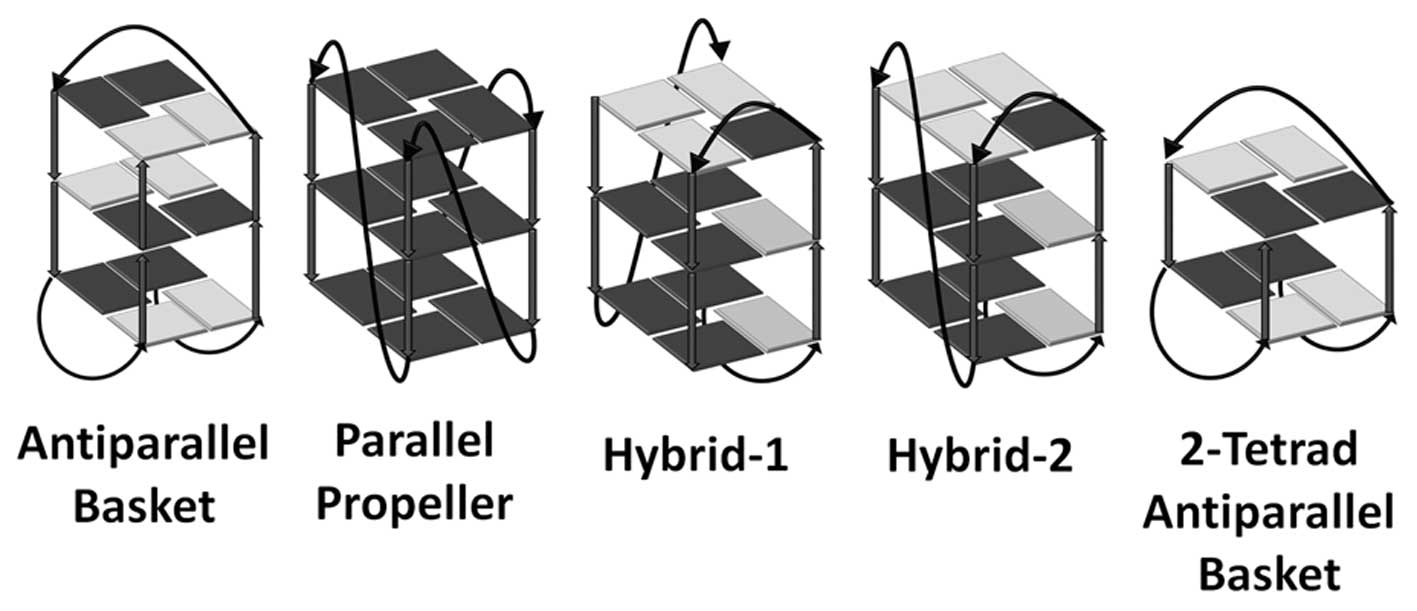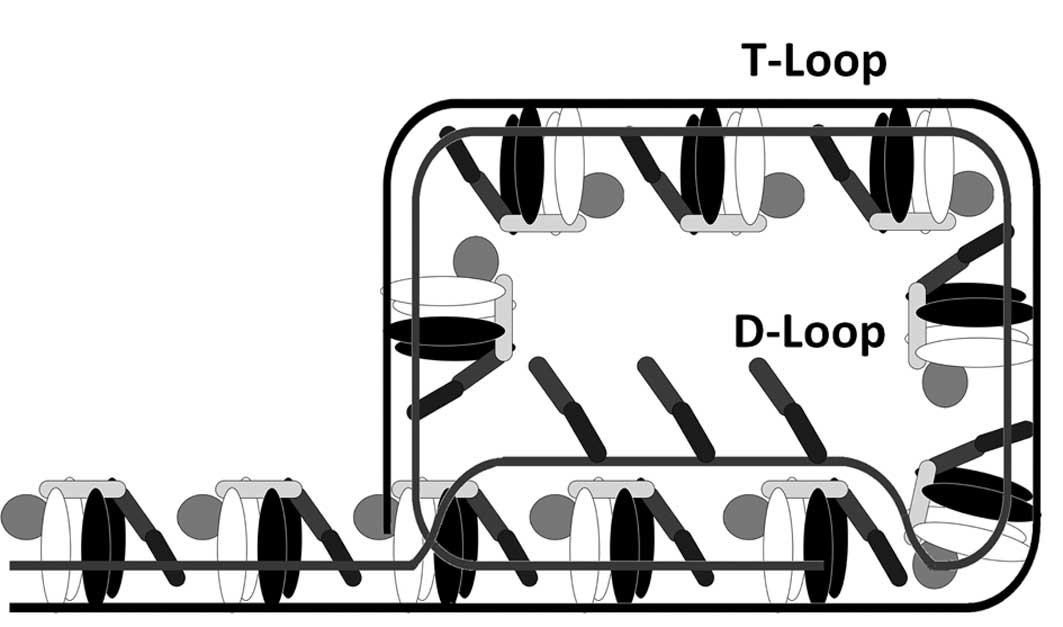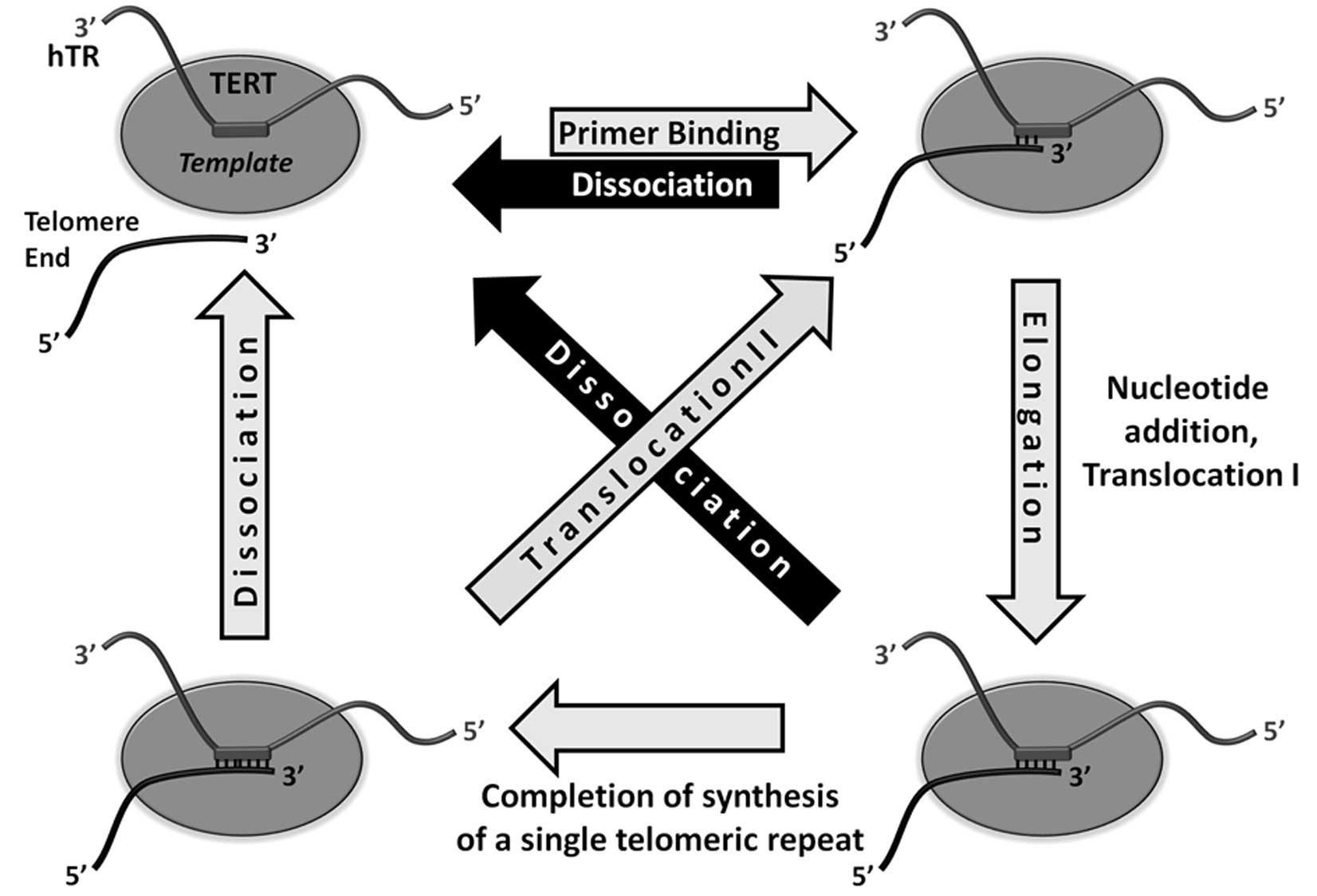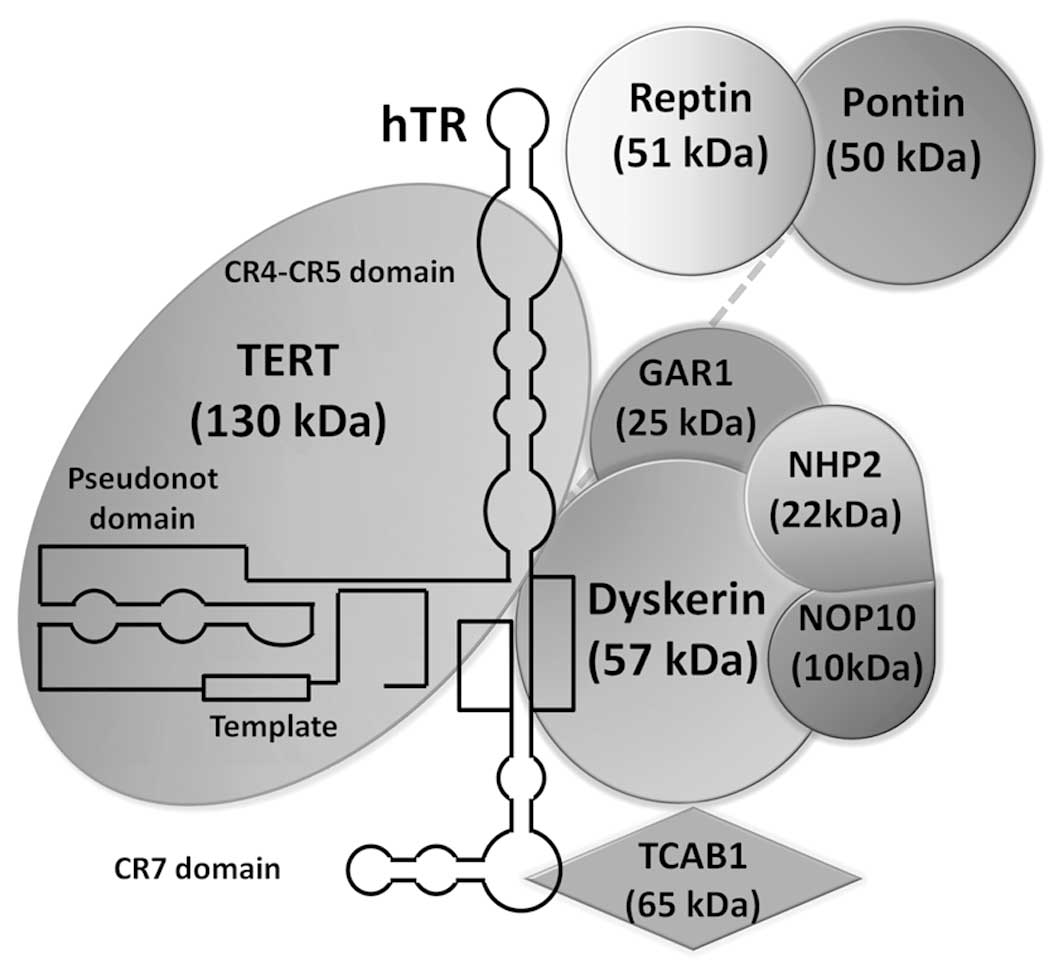|
1.
|
HJ MullerThe remaking of chromosomesThe
Collecting Net131811981938
|
|
2.
|
B McClintockThe stability of broken ends
of chromosomes in Zea maysGenetics26234282194117247004
|
|
3.
|
EH BlackburnJG GallA tandemly repeated
sequence at the termini of the extrachromosomal ribosomal RNA genes
in TetrahymenaJ Mol
Biol1202253197810.1016/0022-2836(78)90294-2
|
|
4.
|
EH BlackburnTelomeres: no end in
sightCell77621623199410.1016/0092-8674(94)90046-98205611
|
|
5.
|
LL SandellVA ZakianLoss of a yeast
telomere: arrest, recovery, and chromosome
lossCell75729739199310.1016/0092-8674(93)90493-A8242745
|
|
6.
|
CW GreiderEH BlackburnIdentification of a
specific telomere terminal transferase activity in
Tetrahymena
extractsCell43405413198510.1016/0092-8674(85)90170-93907856
|
|
7.
|
J MeyneRL RatliffRK MoyzisConservation of
the human telomere sequence (TTAGGG)n among vertebratesProc Natl
Acad Sci USA8670497053198910.1073/pnas.86.18.70492780561
|
|
8.
|
S LejnineVL MakarovJP LangmoreConserved
nucleoprotein structure at the ends of vertebrate and invertebrate
chromosomesProc Natl Acad Sci
USA9223932397199510.1073/pnas.92.6.23937892278
|
|
9.
|
WE WrightVM TesmerKE HuffmanSD LeveneJW
ShayNormal human chromosomes have long G-rich telomeric overhangs
at one endGenes Dev1128012809199710.1101/gad.11.21.28019353250
|
|
10.
|
MI ZverevaDM ShcherbakovaOA
DontsovaTelomerase: structure, functions, and activity
regulationBiochemistry7515631583201021417995
|
|
11.
|
R HänselF LöhrS Foldynová-TrantírkováE
BambergL TrantírekV DötschThe parallel G-quadruplex structure of
vertebrate telomeric repeat sequences is not the preferred folding
topology under physiological conditionsNucleic Acids
Res390576857752011
|
|
12.
|
HDM WyattSC WestTL BeattieInTERTpreting
telomerase structure and functionNucleic Acids
Res3856095612201010.1093/nar/gkq370
|
|
13.
|
BR LingerCM PriceConservation of telomere
protein complexes: shuffling though evolutionCrit Rev Biochem Mol
Biol44434446200910.3109/1040923090330732919839711
|
|
14.
|
W PalmT de LangeHow shelterin protects
mammalian telomeresAnnu Rev
Genet42301334200810.1146/annurev.genet.41.110306.13035018680434
|
|
15.
|
P MartinezMA BlascoTelomeric and
extra-telomeric roles for telomerase and the telomere-binding
proteinsNat Rev Cancer11161176201110.1038/nrc302521346783
|
|
16.
|
L ChongB van SteenselD BroccoliH
Erdjument-BromageJ HanishP TempstT de LangeA human telomeric
proteinScience27016631667199510.1126/science.270.5242.16637502076
|
|
17.
|
A BianchiT de LangeKu binds telomeric DNA
in vitroJ Biol
Chem2742122321227199910.1074/jbc.274.30.2122310409678
|
|
18.
|
A SmogorzewskaB van SteenselA BianchiS
OelmannMR ScheferG SchnappT de LangeControl of human telomere
length by TRF1 and TRF2Mol Cell
Biol2016591668200010.1128/MCB.20.5.1659-1668.200010669743
|
|
19.
|
B van SteenselT de LangeControl of
telomere length by the human telomeric protein
TRF1Nature3857407431997
|
|
20.
|
B van StenselA SmogorzewskaT de LangeTRF2
protects human telomeres from end to end
fusionsCell9240141319989476899
|
|
21.
|
J KarlsederD BroccoliY DaiS HardyT de
Langep53- and ATM-dependent apoptosis induced by telomerase lacking
TRF2Science28313211325199910.1126/science.283.5406.132110037601
|
|
22.
|
JD GriffithL ComeauS RosenfieldRM StanselA
BanchiH MossT de LangeMammalian telomeres end in a large duplex
loopCell97503514199910.1016/S0092-8674(00)80760-610338214
|
|
23.
|
U HerbigWA JoblingBP ChenDJ ChenJM
SedivyTelomere shortening triggers senescence of human cells
through a pathway involving ATM, p53 and p21 (CIP1), but not
p16(INK4a)Mol
Cell14501513200410.1016/S1097-2765(04)00256-415149599
|
|
24.
|
Y GongTA de LangeShd1-controlled POT1a
provides support for repression of ATR signaling at telomeres
through RPA exclusionMol
Cell40377387201010.1016/j.molcel.2010.10.01621070964
|
|
25.
|
CC LeeTS HuangA novel topoisomerase II
poison GL331 preferentially induces DNA cleavage at (C/G)T sites
and can cause telomere DNA damagePharm
Res18846851200110.1023/A:101104883169811474790
|
|
26.
|
P MartinezM ThanasoulaAR CarlosMammalian
Rap1 controls telomere function and gene expression through binding
to telomeric and extratelomeric sitesNat Cell
Biol8768780201010.1038/ncb208120622869
|
|
27.
|
AR BuchmanWJ KimmerlyJ RineRD KornbergTwo
DNA-binding factors recognize specific sequences at silencers,
upstream activating sequences, autonomously replicating sequences
and telomeres in Saccharomyces cerevisiaeMol Cell
Biol82102251988
|
|
28.
|
H TeoS GhoshH LueschTelomere-independent
Rap1 is an IKK adaptor and regulates NF-kappaB-dependent gene
expressionNat Cell Biol12758767201010.1038/ncb208020622870
|
|
29.
|
KK TakaiT KibeJR DonigianD FrescasT de
LangeTelomere protection by TPP1/POT1 requires tethering to TIN2Mol
Cell18647659201110.1016/j.molcel.2011.08.04322099311
|
|
30.
|
AM TejeraM Stagno d’AlcontresM
ThanasoulaTPP1 is required for TERT recruitment, telomere
elongation during nuclear reprogramming, and normal skin
development in miceDev
Cell18775789201010.1016/j.devcel.2010.03.01120493811
|
|
31.
|
P BaumannC PricePot1 and telomere
maintenanceFEBS Lett1037793784201010.1016/j.febslet.2010.05.024
|
|
32.
|
S SchoeftnerMA BlascoDevelopmentally
regulated transcription of mammalian telomeres by DNA-dependent RNA
polymerase IINat Cell Biol10228236200810.1038/ncb168518157120
|
|
33.
|
SG NergadzeBO FarnungH
WischnewskiCpG-island promoters drive transcription of human
telomeresRNA1521862194200910.1261/rna.174830919850908
|
|
34.
|
T De LangeShelterin: the protein complex
that shapes and safeguards human telomeresGenes
Dev1921002110200516166375
|
|
35.
|
SJ HsiaoS SmithTankyrase function at
telomeres, spindle poles and
beyondBiochimie908392200810.1016/j.biochi.2007.07.01217825467
|
|
36.
|
BD CookJN DynekW ChangG ShostakS SmithRole
for the related poly (ADP-Ribose) polymerases tankyrase 1 and 2 at
human telomeresMol Cell
Biol22332342200210.1128/MCB.22.1.332-342.200211739745
|
|
37.
|
Y ChenY YangM van OverbeekJR DonigianP
BaciuT de LangeM LeiA share docking motif in TRF1 and TRF2 used for
differential recruitment of telomeric
proteinsScience31910921096200810.1126/science.115180418202258
|
|
38.
|
XZ ZhouKP LuThe Pin2/TRF1-interacting
protein PinX1 is a potent telomerase
inhibitorCell107347359200110.1016/S0092-8674(01)00538-411701125
|
|
39.
|
M Van OverbeekT de LangeApollo, an
Artemis-related nuclease interacts with TRF2 and protects human
telomerase in S phaseCurr Biol1612951232200616730176
|
|
40.
|
JB BaeSS MukhopadhyayL LiuSnm1B/Apollo
mediates replication fork collapse and S phase checkpoint
activation in response to DNA interstrand
cross-linksOncogene2750455056200810.1038/onc.2008.13918469862
|
|
41.
|
JF SarthyP BaumannApollo-taking the lead
in telomere protectionMol
Cell39489491201010.1016/j.molcel.2010.08.01820797622
|
|
42.
|
Y DengX GuoDO FergusonS ChangMultiple
roles for MRE11 at uncapped
telomeresNature460914918200910.1038/nature0819619633651
|
|
43.
|
JH LeeTT PaullActivation and regulation of
ATM kinase activity in response to DNA double-strand
breaksOncogene2677417748200710.1038/sj.onc.121087218066086
|
|
44.
|
HB LandsverkF Mora-BermúdezOJ LandsverkThe
protein phosphatase 1 regulator PNUTS is a new component of the DNA
damage responseEMBO
Rep11868875201010.1038/embor.2010.13420890310
|
|
45.
|
DH MohammadMB Yaffe14-3-3 proteins, FHA
domains and BRXT domains in the DNA damage responseDNA
Repair810091017200910.1016/j.dnarep.2009.04.00419481982
|
|
46.
|
D KiplingRG FaragherProgeroid syndromes:
probing the molecular basis of aging?Mol
Pathol50234241199710.1136/mp.50.5.2349497912
|
|
47.
|
A OzgencLA LoebCurrent advances in
unraveling the function of the Werner syndrome proteinMutat
Res577237251200510.1016/j.mrfmmm.2005.03.02015946710
|
|
48.
|
PL OpreskoC Von KobbeJP LaineJ HarriganID
HicksonVA BohrTelomere binding protein TRF2 binds to and stimulates
the Werner and Bloom syndrome helicasesJ Biol
Chem2774111041119200210.1074/jbc.M20539620012181313
|
|
49.
|
A SahariaL GuittatS CrockerA LimM SteffenS
KulkarniSA StewartFlap endonuclease 1 contributes to telomere
stabilityCurr Biol18496500200810.1016/j.cub.2008.02.07118394896
|
|
50.
|
A SahariaDC TeasleyJP DuxinB DaoKB
ChiappinelliSA StewartFEN1 ensures telomere stability by
facilitating replication fork re-initiationJ Biol
Chem2852705727066201010.1074/jbc.M110.11227620551483
|
|
51.
|
JF DiffleyL LabibThe chromosome
replication cycleJ Cell Sci1158698722000
|
|
52.
|
Z DengJ DheekolluD BroccoliA DuttaPM
LiebermanThe origin recognition complex localizes to telomere
repeats and prevents telomeric-circle formationCurr
Biol1719891995200710.1016/j.cub.2007.10.05418006317
|
|
53.
|
Z DengJ NorseenA WiedmerH RietmanPM
LiebermanTERRA RNA binding to TRF2 facilitates heterochromatin
formation and ORC recruitment at telomeresMol
Cell35403413200910.1016/j.molcel.2009.06.02519716786
|
|
54.
|
A CicciaSJ ElledgeThe DNA damage response:
making it safe to play with knivesMol
Cell40179204201010.1016/j.molcel.2010.09.01920965415
|
|
55.
|
T KibeGA OsawaCE KeeganT de LangeTelomere
protection by TPP1 is mediated by POT1a and POT1bMol Cell
Biol3010591066201010.1128/MCB.01498-0919995905
|
|
56.
|
TM BryanA EnglezouL Dalla-PozzaMA DunhamRR
ReddelEvidence for an alternative mechanism for maintaining
telomere length in human tumors and tumor-derived cell linesNat
Med312711274199710.1038/nm1197-12719359704
|
|
57.
|
MA DunhamAA NeumannCL FaschingRR
ReddelTelomere maintenance by recombination in human cellsNat
Genet26447450200010.1038/8258611101843
|
|
58.
|
Q ChenA IjpmaCW GreiderTwo survivor
pathways that allow growth in the absence of telomerase are
generated by distinct telomere recombination eventsMol Cell
Biol2118191827200110.1128/MCB.21.5.1819-1827.200111238918
|
|
59.
|
P HuangFE PrydeD LesterRL MaddisonRH
BortsID HicksonEJ LouisSGS1 is required for telomere elongation in
the absence of telomeraseCurr
Biol11125129200110.1016/S0960-9822(01)00021-511231130
|
|
60.
|
A RizkiV LundblandDefects in mismatch
repair promote telomerase-independent
proliferationNature411713716200110.1038/3507964111395777
|
|
61.
|
CB HarleyAB FutcherCW GreiderTelomeres
shorten during ageing of human
fibroblastsNature345458460199110.1038/345458a02342578
|
|
62.
|
RC AllsoopCB HarleyEvidence for a critical
telomeric length in senescent human fibroblastsExp Cell
Res219130136199510.1006/excr.1995.12137628529
|
|
63.
|
J CampisiThe biology of replicative
senescenceEur J
Cancer33703709199710.1016/S0959-8049(96)00058-59282108
|
|
64.
|
H VaziriS BenchimolReconstitution of
telomerase activity in normal human cells lead to elongation of
telomeres and extended replicative life spanCurr
Biol8279282199810.1016/S0960-9822(98)70109-59501072
|
|
65.
|
E ChangCB HarleyTelomere length and
replicative aging in human vascular tissuesProc Natl Acad Sci
USA921119011194199510.1073/pnas.92.24.111907479963
|
|
66.
|
AG BodnarNW KimRB EffrosCP ChiuMechanism
of telomerase induction during T cell activationExp Cell
Res2285864199610.1006/excr.1996.02998892971
|
|
67.
|
ND HastieM DempsterMG DunlopAM ThompsonDK
GreenRC AllshireTelomere reduction in human colorectal carcinoma
and with ageingNature346866868199010.1038/346866a02392154
|
|
68.
|
CM CounterAA AvillonCE LeFeuvreNG
StewartCW GreiderCB HarleyS BacchettiTelomere shortening associated
with chromosome instability is arrested in immortal cells witch
express telomerase activityEMBO J111921192919921582420
|
|
69.
|
K DhaeeneE Van MarckR ParwareschTelomeres,
telomerase and cancer: an up-dateVirchows
Arch437116200010.1007/s004280000189
|
|
70.
|
LR GauthierC GranotierJC SoriaS FaivreV
BoigeE RaymondFD BoussinDetection of circulating carcinoma cells by
telomerase activityBr J
Cancer84631635200110.1054/bjoc.2000.166211237383
|
|
71.
|
JC SoriaLR GauthierE RaymondMolecular
detection of telomerase positive circulating epithelial cells in
metastatic breast cancer patientsClin Cancer Res59719751999
|
|
72.
|
J PfitzenmaierWJ EllisEW ArfmanS HawleyPO
McLaughlinPH LangeRL VessellaTelomerase activity in disseminated
prostate cancer cellsBJU
Int9713091313200610.1111/j.1464-410X.2006.06194.x16686730
|
|
73.
|
AJ WalneI DokalDyskeratosis Congenita: a
historical perspectiveMech Ageing
Dev1294859200810.1016/j.mad.2007.10.00618054794
|
|
74.
|
T VulliamyA MarroneI DokalPJ
MasonAssociation between aplastic anaemia and mutations in
telomerase
RNALancet2221682170200210.1016/S0140-6736(02)09087-612090986
|
|
75.
|
N NishioS KojimaRecent progress in
dyskeratosis congenitaInt J
Hematol92419424201010.1007/s12185-010-0695-520882440
|
|
76.
|
M ArmaniosTelomerase and idiopathic
pulmonary fibrosisMutat
Res7305258201210.1016/j.mrfmmm.2011.10.01322079513
|
|
77.
|
M ArmaniosSyndromes of telomere
shorteningAnnu Rev Genomics Hum
Genet104561200910.1146/annurev-genom-082908-150046
|
|
78.
|
D FuK CollinsPurification of human
telomerase complexes identifies factors involved in telomerase
biogenesis and telomere length regulationMol
Cell28773785200710.1016/j.molcel.2007.09.02318082603
|
|
79.
|
AS VeinteicherZ MengPJ MasonTD VeenstraSE
ArtandiIdentification of ATPases pontin and reptin as telomerase
components essential for holenzyme
activityCell132945957200810.1016/j.cell.2008.01.01918358808
|
|
80.
|
F ZhongSA SavageM ShkreliDisruption of
telomerase trafficking by TCAB1 mutation causes dyskeratosis
congenitaGenes Dev251116201110.1101/gad.200641121205863
|
|
81.
|
SB CohenME GrahamGO LovreczN BachePJ
RobinsonRR Red delProtein composition of catalytically active human
telomerase from immortal
cellsScience3018501853200710.1126/science.113859617395830
|
|
82.
|
LA BryceN MorrisonSF HoareS MuirWN
KeithMapping of the gene for the human telomerase reverse
transcriptase, hTERT, to chromosome 5p15.33 by fluorescence in situ
hybridizationNeoplasia2197201200010.1038/sj.neo.790009210935505
|
|
83.
|
S KyoM TakakuraT FujiwaraM
InoueUnderstanding and exploiting hTERT promoter regulation for
diagnosis and treatment of human cancersCancer
Sci9915281538200810.1111/j.1349-7006.2008.00878.x18754863
|
|
84.
|
MA BlascoW FunkB VilleponteauCW
GreiderFunctional characterization and developmental regulation of
mouse telomerase
RNAScience26912671270199610.1126/science.75444927544492
|
|
85.
|
CJ CairneyWN KeithTelomerase redefined:
integrated regulation of hTR and hTERT for telomere maintenance and
telomerase
activityBiochimie901323200810.1016/j.biochi.2007.07.02517854971
|
|
86.
|
DA TsaoCW WuYS LinMolecular cloning of
bovine telomerase
RNAGene2215158199810.1016/S0378-1119(98)00432-69852949
|
|
87.
|
GB MorinThe human telomere terminal
transferase enzyme is a ribonucleoprotein that synthesizes TTAGGG
repeatsCell59521529198910.1016/0092-8674(89)90035-42805070
|
|
88.
|
JL ChenMA BlascoCW GreiderSecondary
structure of vertebrate telomerase
RNACell100503514200010.1016/S0092-8674(00)80687-X10721988
|
|
89.
|
CA TheimerJ FeigonStructure and function
of telomerase RNACurr Opin Struct
Biol16307318200610.1016/j.sbi.2006.05.005
|
|
90.
|
JI ParkAS VenteicherJY HongTelomerase
modulates Wnt signaling by association with target gene
chromatinNature4606672200910.1038/nature0813719571879
|
|
91.
|
Y MaidaM YasukawaM FuruuchiRNA-dependent
RNA polymerase formed by TERT and the RMRP
RNANature4610230235200910.1038/nature0828319701182
|
|
92.
|
Y CongJW ShayActions of human telomerase
beyond telomeresCell Res18725732200810.1038/cr.2008.7418574498
|
|
93.
|
JH SantosJN MeyerM SkorvagaLA AnnabB Van
HoutenMitochondrial hTERT exacerbates free-radical-mediated mtDNA
damageAging
Cell6399411200410.1111/j.1474-9728.2004.00124.x15569357
|
|
94.
|
JH SantosJN MeyerB Van HoutenMitochondrial
localization of telomerase as a determinant for hydrogen
peroxide-induced mitochondrial DNA damage and apoptosisHum Mol
Genet1517571768200610.1093/hmg/ddl09816613901
|
|
95.
|
I TárkányJ AradiPharmacological
intervention strategies for affecting telomerase activity: Future
prospects to treat cancer and degenerative
diseaseBiochimie901561722008
|



















